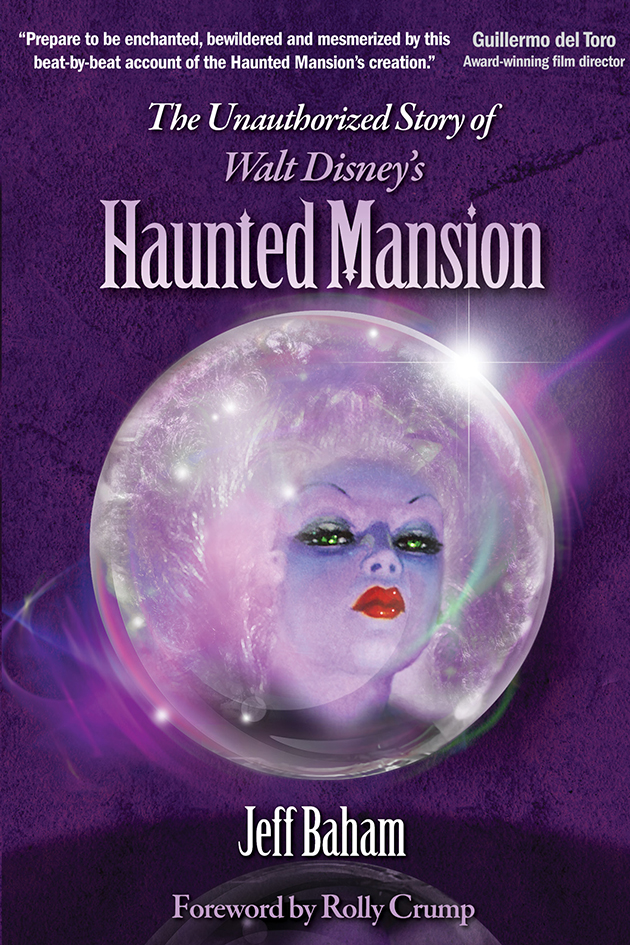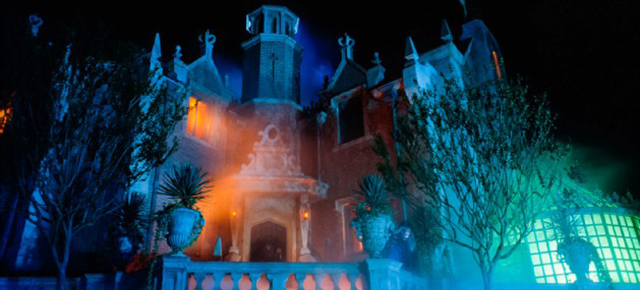“Perhaps Madame Leota can establish contact,” the Ghost Host decides. “She has a remarkable head for materialising… the disembodied!” As the Ghost Host is speaking, the Doom Buggies make their way into a dim parlor and take their place around a large seance circle.
This is Part One of a two-part excerpt from The Unauthorized Story of Walt Disney’s Haunted Mansion, by Jeff Baham, published by Theme Park Press, and reprinted here with permission.
Throughout the room, ghostly musical instruments and other objects float in response to the supplications of Madame Leota, a glowing, chanting head, speaking from within a misty crystal ball planted on the center of a thick, ornate table covered with Tarot cards and symbols of the supernatural. Perched behind her on a large gilded chair is the raven we first met in the conservatory, flapping its wings in response to the eerie occurrences taking place. As Leota chants, the instruments respond one by one with otherworldly charm, and a mysterious, ectoplasmic vapor in the corner of the room winds around like a serpent with a fading tail, occasionally seeming to materialise into an eerily familiar visage before vanishing into a wisp again.
The floating objects are illuminated dimly with black lighting, which causes them to glow and limits the amount of illumination on the black cables supporting them. They are attached to a simple motor-driven lift mechanism that rotates slowly, causing the props to seem to float up and down, slowly and mysteriously. The mysterious “ectoplasm” is an interesting effect which is also motor-driven, and activated by a light on the tip of the mechanism. This contraption is positioned behind a semi-opaque portion of the wall, which is coated with phosphorescent dye. When the small yet intense point of light passes directly behind the wall, it activates the phosphorescence, which glows through the wall and is visible to the patrons in the Doom Buggies. As is the case with all light-activated phosphorescent mate- rials (such as a typical “glow-in-the-dark” toy), the phosphorescence quickly fades, leaving a faint tail trailing the moving point of light.
Leota chants:
Serpents and spiders, tail of a rat…call in the spirits, wherever they’re at! Rap on a table, it’s time to respond…send us a message from somewhere beyond! Goblins and ghoulies from last Hallowe’en… awaken the spirits with your tambourine! Creepies and crawlies, toads in a pond…let there be music, from regions beyond! Wizards and witches, wherever you dwell…give us a hint, by ringing a bell!
The animation of Madame Leota’s face is the first truly magical effect in the Haunted Mansion achievable only through technology. Leota’s chanting visage is a projection of a real human face, filmed while speaking the lines. The “actress” is Leota Toombs, who was working for WED at the time of the Haunted Mansion’s development, using her own costuming and modelling skills on other attractions such as It’s a Small World and Pirates of the Caribbean. Toombs also took a shot at recording the audio for the scene as well, but the Imagineers were looking for something a little darker and more threatening, so they turned to one of their more wicked voice talents, Eleanor Audley. Audley is pure villainess, having previously voiced the evil characters Maleficent (for Sleeping Beauty) and Lady Tremaine (the stepmother from Cinderella). Audley gives Madame Leota a dark menace, while Toombs provides a striking, grim visual. With the natural glow that comes along with the projection process, the effect is quite eerie.
In 1969, when Disneyland premiered the Haunted Mansion, the effect was accomplished using regular looped film projection, shining Leota’s face onto a static neutral-coloured head inside of a large crystal ball. Wild white hair surrounded the head and filled the rest of the ball, and purple backlighting gave the set an otherworldly glow. The projector would leave a tiny highlight reflected in the glass ball, but that didn’t keep people from being mystified by the effect. The trick was first devised by Yale Gracey when he was working on the Haunted Mansion with Rolly Crump in the early 1960s. Gracey simply dreamed up the idea one day, went to find an old film reel of a talking head (and ended up using some television footage that Hans Conried had done for the studio), and started shining it on various items and props until he found an old bust of Beethoven. When he projected the film onto the bust and turned out the lights, Beethoven sprang to life. Walt loved it, and it became the basis for the Madame Leota effect.

Leota Toombs actually enjoyed a measure of celebrity due to her role in the Haunted Mansion. “Mum said they tied her hair to the chair,” said Imagineer Kim Irvine, Toombs’s daughter, talking about the process Toombs went through to be filmed for the attraction. “She was kind of surprised that out of her whole career at WED, she would be so famous for being Madame Leota. She said that one day she was walking through the park, and a young attraction hostess ran up to her and said ‘You are her — you’re her, aren’t you? My friends tell me you’re Madame Leota!’ Mum was flattered and said, ‘Well yes, that is me,’” Irvine recalled. “Then [the hostess] said, ‘I just have to ask you one question — don’t you get tired of sitting there with your head under that ball?’”
In the 1990s, the system was replaced with a new technology patented by WDI, in which the film (since transferred to a digital format) was projected (via fibre optics, carried into the head through the neck) onto the backside of an opaque static face from inside the middle of the head. A tiny lens was used to project an extremely wide angle, allowing the projection to cover the entire inside of the front of the head. The benefit to this technology was mobility; the head could now be moved about, as the lens remained constantly fixed inside, only needing to be tethered through a fibre optics cable. In fact, this allowed the scene to be altered slightly, in which the table itself could be moved up and down as if it were floating along with the rest of the objects in the room. The small reflection in front of the crystal ball was also eliminated, since the projection was from within.
However, this system had its problems as well. The opaque head that allowed the projection to show through from within necessarily allowed for a dimmer, more muted image than the bright incandes- cent projection from outside. The image was also more distorted when viewed from the sides, a result of the wider angle of projection. When the Haunted Mansion Holiday overlay was installed at Disneyland in 2001, Madame Leota returned to her former externally-projected glory, her table again firmly planted in place, with four new lit candles surrounding the ball, their highlights reflected by the crystal to distract viewers from the projector’s reflection.
Still not content with the scene, the Imagineers turned back to Disneyland’s seance circle in 2004 and gave even more life to Madame Leota by causing her crystal ball to levitate and fly around the table. Practical technology to create a mechanical means to synchronise a projection with the “flying” crystal ball didn’t exist until recently, but with the advent of brilliant, high-definition video projection technology, a solution was designed. The entire field of space which contained the path of the floating crystal ball became a virtual “screen” for the high definition projection. A computer had the predefined path which the ball would follow programmed into its memory, and the face of Leota (still the original, menacing Leota Toombs) followed that path, much like a bouncing ball on a computer screensaver. This functioned for a brief time, until newer, crisper technology allowed for Leota’s projection to again come from within the head itself, projected onto the front of the face from behind, which is where the technology stands — at least as of this writing. The rear-projection also allowed the Imagineers to use a full high-resolution image for Madame Leota’s face, as opposed to Disneyland’s projected “bouncing ball” image, which is essentially a very small portion of the full high-resolution projection that covered the full moving path of the crystal ball.
The set was also redressed as part of the 2004 update, and now there are many new candles on the table (with more new technol- ogy — amazingly realistic flickering electric flames), and a new spell book that sets next to the seance table, inevitably turned to page 1313, which “spells” out Leota’s incantation designed to “bring to your eyes and ears one who is bound in limbo.”
Leaving the seance circle, the Doom Buggies move through a dark hallway toward a large balcony overlooking a grand hall. Crazy, discordant pipe organ music fills the hallway as the Doom Buggies turn to peer over the balcony rail. Referring to the seance the patrons just left behind, the Ghost Host resumes his narration:
The happy haunts have received your sympathetic vibrations, and are beginning to materialise. They’re assembling for a swinging wake, and they will be expecting me. I’ll see you all a little later…
Check back tomorrow for Part Two of our excerpt series from The Unauthorized Story of Walt Disney’s Haunted Mansion, by Jeff Baham.
